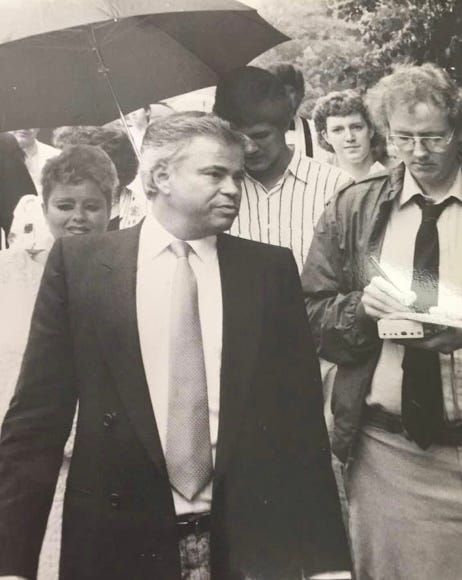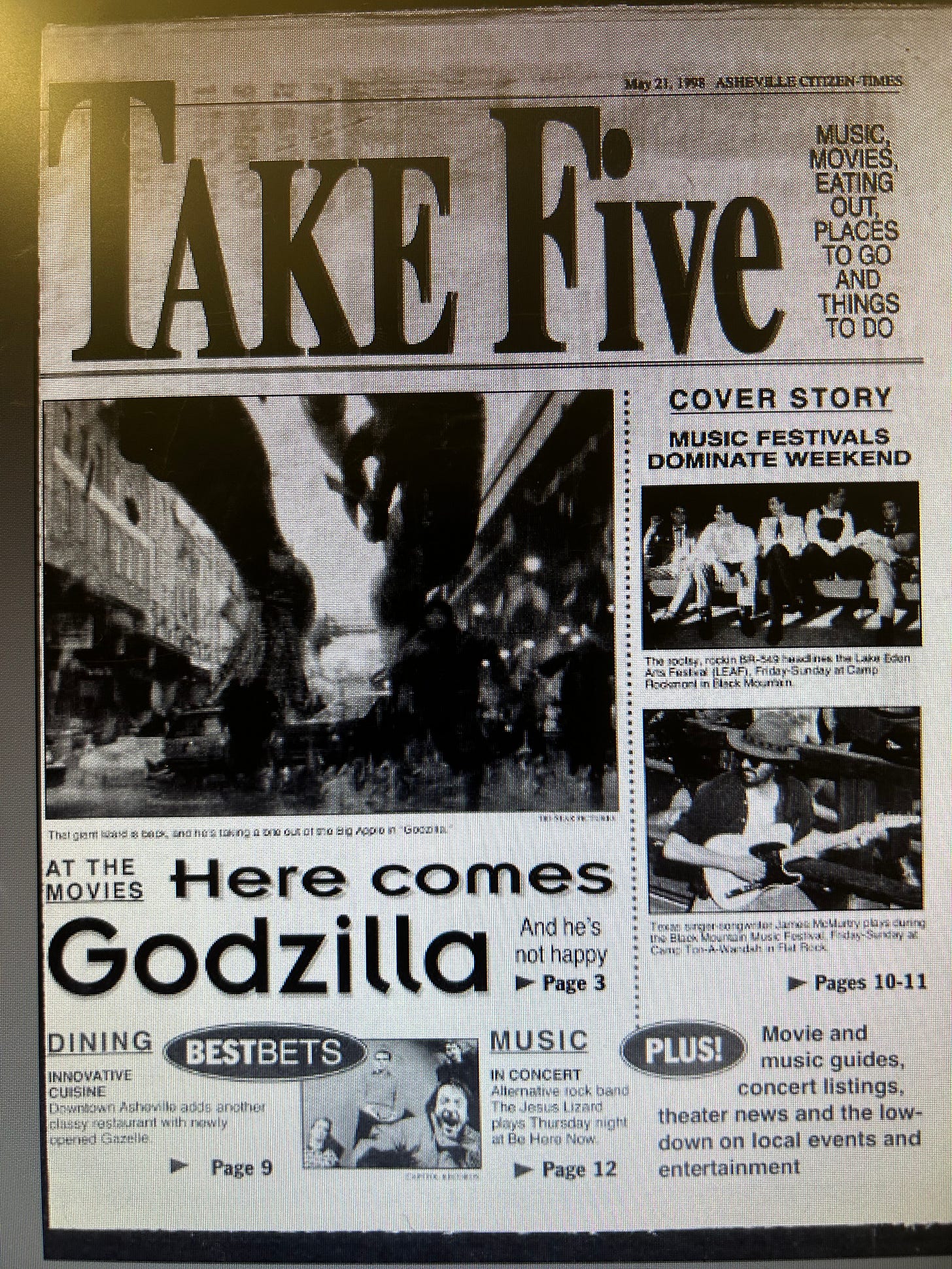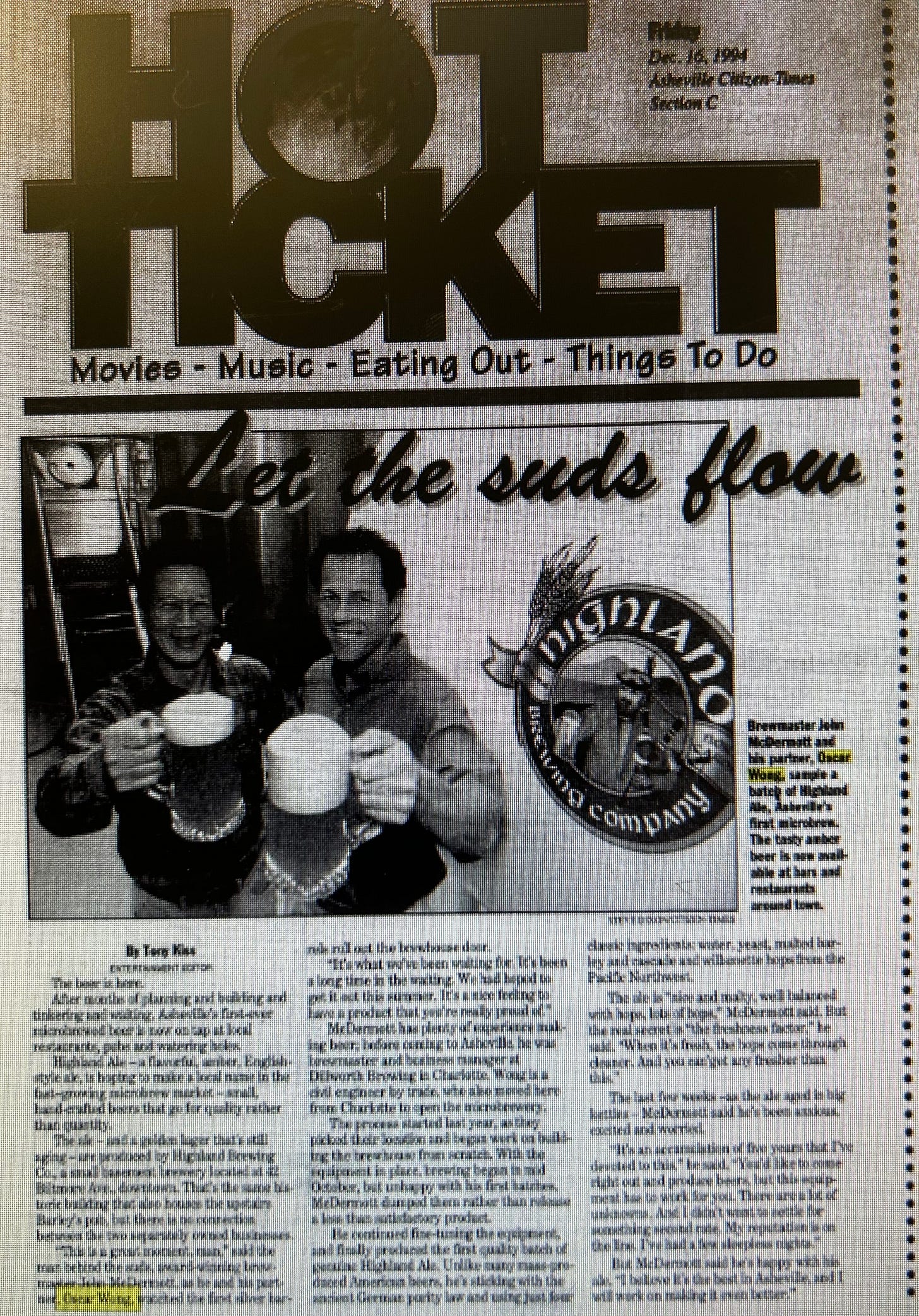From the wacky to the worthwhile, and just about everything in between, Tony Kiss chronicled the rise of Asheville's entertainment scene over three decades. Here's a look back.
Tony may be best remembered as 'The Beer Guy,' but he spent years highlighting the community's performing arts and music scene

This story sponsored by Citizens Fuel Co., a family-owned Asheville company.
Tony Kiss, the kind-hearted newspaper chronicler of the Asheville entertainment scene as it rose from small-town obscurity to national notoriety over the course of three decades, died Aug. 17. He was 68.
I met Tony at the tail end of 1992 when I moved back to Asheville to work for my hometown newspaper. My desk sat right across from Tony’s, and I watched and listened as he worked. He was a mentor.
With overlapping Sunday shifts, I spent hours in a nearly empty newsroom listening to Tony’s stories. I was captivated.
Tony had a Vaudevillian flair, and he had running “schticks” with many friends, including me. We called each other “partner” and shared that dark humor found in newsrooms straining under the weight of cranky copy editors and hard deadlines.
Tony wrote scores of stories during his 32-year career at the Asheville Citizen-Times, shining a spotlight on the city’s nascent performing arts and music scene, profiling its craft beer industry pioneers and mentoring a cadre of young writers. His byline became synonymous with stories that celebrated the artistic spirit of Asheville as he showcased the city’s unique cultural offerings and the people who brought it all to life.
He may be best remembered as “The Beer Guy,” the nickname he adopted as he detailed the establishment and growth of Asheville craft brewing, which now stands as a billion dollar industry. But long before Asheville was ever known as “Beer City, USA,” Asheville aspired to be an arts destination. When Tony came to town in the mid-1980s, the city endeavored to live up to its “Paris of the South” moniker, and his many stories describing local artists and community art institutions helped bolster that reputation over the course of nearly 20 years before his first beer column was published.

Growing up in Kingsport, Tenn., Tony got to know newspapers from his mother, Mary, who forged a 40-year career as an award-winning reporter at the Kingsport Times-News. That’s where he landed his first writing gig in the mid-1970s.
As a newspaper intern in 1977, Tony wrote a feature story about Mike James, a raspy-voiced, influential late-night radio DJ known as the Tennessee Midnight Rambler. “That dude was Wolfman Jack on steroids,” Tony wrote years later. “Played the loudest hardest rock on the air. It’s hard today to even imagine what a force he was. That was when radio really meant something.”
Tony later said that he always believed that that story launched his newspaper career.

From there Tony moved on to the Anderson Independent. (The Anderson Independent and the Anderson Daily Mail were merged in 1981 to become the Anderson Independent-Mail.) Working the newspaper’s police beat in rural upstate South Carolina, Tony came across all manner of gory shootings, stabbings and killings. He also found newspaper story gold.
Tony awoke to a ringing phone about 5 a.m. one September morning in 1980. It was his editor calling with an urgent order to get to the home of Jim McAlister. The man had just called police to report an unidentified flying object. Flying saucers?! Tony bolted.
“There were lights and windows all around this thing,” Tony reported McAlister telling him in a front page story the next day. “It was just like the pictures of flying saucers you see in magazines.” In the weeks and months that followed, media organizations and UFO hunters from around the world sought out McAlister, as well as the reporter who had the scoop. Tony handled it all like a pro.

In 1984, Asheville was in the midst of a reawakening after decades of stagnation. Enter Tony Kiss, who wrote for The Asheville Citizen, the daily morning newspaper. (The Asheville Citizen and The Asheville Times, the afternoon newspaper, merged in 1991.)
It wasn’t long before he had his first big story - the arrival of a world-renowned dancer.
Mikhail Baryshnikov’s June performance at the Thomas Wolfe Auditorium ranked as “perhaps the biggest cultural/entertainment event ever held in these parts,” Tony wrote in advance of the show. (Note: Tony was never afraid of a little hyperbole. Elvis Presley played three rousing concerts a sold-out Asheville Civic Center crowd of 7,500 each time back in 1975, but then again, the Elvis and the ballet audiences didn’t exactly overlap.)
Tony described the Baryshnikov show in a June 22, 1984 story for The Asheville Citizen: “More than 2,300 people packed the plush auditorium for the 2 1/2-hour concert, which broke several local records, including quickest sellout and highest ticket prices.” Baryshnikov returned to Asheville two years later to the same enthusiastic reception. In true Tony fashion, he dubbed it “Misha madness.”
In October 1984 Tony ventured down to an industrial wasteland along the banks of French Broad River to check out the dusty interior of an abandoned mill. Entrepreneur Cam Metcalf told Tony he dreamt of turning the old Earle-Chesterfield Mill into a thriving arts center. It would be one of the first stories documenting local efforts to create what we now celebrate as the River Arts District.
Then in November, Tony wrote about yet another colorful character’s stop in town. “Prince, the rock singer and star of the film ‘Purple Rain,’ made a brief unannounced stop in Asheville Wednesday morning” at the Asheville Mall, Tony wrote in a Nov. 15, 1984 story.
Prince visited the Pet Luv pet shop dressed in a long full-length fur coat, no shirt, white leather pants and purple knee boots and paid for a poodle with a credit card, signing his name, Prince Nelson, on a receipt that the shop owner planned to frame, Tony reported.
In his early days at Citizen, Tony occasionally covered breaking news stories. One story he reveled in retelling was about the time he covered a snake-handling preacher’s religious service in Haywood County. In August 1985, Tony described how Haywood County Sheriff Jack Arrington was bitten by a poisonous rattlesnake while attempting to stop the Canton service.
About 100 people had gathered for the service, which started when the preacher lit a bottle of flammable liquid and held the burning container dangerously close to his face, Tony wrote. “At least one observer, a middle-aged woman, was “talking in tongues” - jabbering unintelligibly - during the service,” he noted.
In the waning days of 1985, Tony looked back on the year and took special notice of the first year of Asheville Music Hall, “one of the best things to happen to the city’s nightlife,” he wrote. Located on the downtown alley called Wall Street, the venue brought John Prine, Weird Al, John Lee Hooker and the original Byrds to town, just to name a few. (Tony also told a great story about Greg Allman going on about his ex-wife Cher before an appearance at the Music Hall back around ‘86.)
He went on to mention other highlights of the year: performances by Doc Watson and Taj Mahal at the ineffable McDibb’s listening room; crowd-pleasing shows at the long-running Mountain Dance and Folk Festival and Shindig on the Green; and WCQS-FM finally joining the NPR and APR networks.
“Now and then, I’ll still hear someone say that Asheville doesn’t offer much in the way of culture of entertainment,” he wrote. “If only they realized how wrong they are.”
Sometimes, celebrity worlds collided right before Tony’s eyes.
In the summer of 1988, he was excited to cover a performance of the famous comedian Sid Caesar at the Brevard Music Center. Tony loved old radio and television comedy - “a little song, a little dance, a little seltzer down the pants,” he like to remark - and Tony jumped at the chance to interview Caesar in advance of his visit.

But Caesar was upstaged a bit when Jim and Tammy Bakker, the scandal-plagued evangelists who had built an empire with their PTL Christian television ministry, set the Sunday afternoon audience abuzz as they made their way across the auditorium to find their seats with their Hendersonville attorney, Jim Toms. Jim Bakker financial misdeeds, and an affair with church secretary Jessica Hahn, had been national headlines the year before.
In a column some 20 years later, Tony recalled walking across the Brevard Music Center grounds, firing questions at Jim, who answered amiably enough, while Tammy Faye remained silent. “As we arrived at a reception for Caesar, I thanked Bakker for the interview, and at that point Tammy Faye opened up, exclaiming, ‘They’re all out to get us,’ or something to that effect,” Tony wrote. “It came out of nowhere and was startling. I mumbled something like, ‘Yes, ma’am,’ and left the Bakkers to return to the paper to file my story. You don’t forget something like that.”
The footnote to this story is that James Bakker spent several months in the Salvation Army’s halfway house in Asheville in 1994 after serving four and a half years in federal prison for defrauding investors out of millions of dollars.
Despite the breakthroughs on the local performing arts scene, Asheville residents in search of a fun distraction still relied heavily on mass media: radio music, television shows and movies. Tony covered it. New disc jockeys caught his attention. The latest video rental shop titles got mentioned, as did the channel additions to the Asheville Cablevision line-up. Big movie releases got reviewed.
Still, Tony sought to build up the small, local efforts aimed at expanding entertainment options. A group of dedicated movie-lovers who organized a film series called Cinematique received regular notice from Tony. In one column, he praised the group for bringing to town such obscure films as “Stop Making Sense,” the acclaimed concert film starring The Talking Heads.
“The movie was released some time ago, but with all the Ninja sagas and juvenile sex comedies out there, the cinemas in our fair city apparently couldn’t find time to show it,” he wrote in February 1986. “So it was Cinematique to the rescue.”
As the 1990s rolled around, Tony continued his prodigious written output. He also kept up a nonstop schedule of attending concerts, shows and events. He was there in 1992 when a new listening room called Be Here Now replaced a crumbling pool hall on Biltmore Avenue. “Owner Chris Hardwicke has spent a lot of time, thought and money making Be Here Now something special,” Tony wrote. “One of the most interesting aspects is the no-smoking policy.”
In a 1994 story headlined “Let the Suds Flow,” Tony described the opening of a new brewery in downtown Asheville called Highland Brewing Co., “a small basement brewery” at 42 Biltmore Ave., he wrote. Owner Oscar Wong and business parter/brewmaster John McDermott had been working for more than a year on their microbrewery. In a follow-up column, Tony felt compelled to clear up some confusion among his readers regarding the difference between a brewpub and a microbrewery.
In 1998, Tony covered the first major label album release of Asheville rock guitarist Warren Haynes’ band, Gov’t Mule. The record, “Dose,” further established Haynes, already well-known as a member of the Allman Brothers Band, “as one of the nation’s premier guitarists,” Tony wrote.
And in 1999, Tony was thrilled to report the reopening of The Grey Eagle Music Hall in Asheville. “The new Grey Eagle Music Hall is expected to be a cornerstone in Asheville’s vibrant French Broad River district, a thriving area that’s already home to dozens of artist studios,” he wrote.

Tony’s coverage first landed in the newspaper’s Sunday arts and leisure section. As local entertainment options grew, some of his coverage moved to Fridays under the banner “Hot Ticket.” Then, in 1998, the newspaper elevated Tony’s coverage as it launched “Take Five,” a section that was inserted into the daily newspaper and also distributed for free in separate boxes on the street. (Part of that strategy was aimed at challenging Asheville’s alternative weekly newspaper, Mountain Xpress, long a burr in the ACT saddle for siphoning away advertising dollars.)
With a higher profile came a need for more hands on deck. Tony began assembling a cadre of freelance writers, including Amy Jones, Heather Rayburn, Susan Parke and Carol Rifkin, just to name a few. He playfully referred to them as his “minions.” Many were first-time writers, and many became life-long friends.
Aside from all the exciting new cultural happenings, Tony always delighted in covering a couple of annual events. One was the arrival of the Ringling Brothers and Barnum & Bailey Circus. The circus ranked as one of the biggest entertainment events of the year in Asheville, and Tony always gave it big play in his pages. (One year, he described a controversial “shaggy sensation” of a circus act called The Living Unicorn.) Tony would also occasionally serve as a ceremonial ringmaster.
Bele Chere, the other big yearly party, never failed to get Tony fired up for a good time. The event unfolded right outside the newspaper’s front doors at 14 O. Henry Ave. downtown. Thousands of visitors filled downtown streets to collect handmade crafts, fill up on funnel cakes (and beer) and dance to the live music at multiple outdoor stages. Tony would inevitably end up at Magnolia’s bar and restaurant, an entertainment hot spot that featured one of his favorite visiting entertainers, the rockabilly raconteur Rev. Billy C. Wirtz.
Flat Rock Playhouse, the professional theater known for the quality of its popular musicals, comedies and dramas since its opening in 1937, also received Tony’s attention and praise. Tony became close friends with Robin Farquhar, son of the theater’s founder, who directed the playhouse from 1983 until his death in 2008.
As the calendar rolled over to the year 2000, Tony’s reporting continued with a focus on Asheville’s growing craft beer scene. His Beer Guy column became a popular weekly read. But the newspaper industry was changing. By the 2010s, budget cuts, furloughs and layoffs were becoming an annual occurrence at the corporate-owned (Gannett) newspaper.
Tony was laid off in 2016. And while he continued to write about beer for the Mountain Xpress for a couple of years, Tony’s health began to deteriorate.
Tony’s deep connection with newspapers, and his joy in storytelling, will forever remain with me. The stories we tell have the power to create lasting legacies.
Tony will be deeply missed and fondly remembered by all whose lives he touched.
A celebration of his life will be held at 5 p.m. Thursday at Rabbit Rabbit in downtown Asheville.
Thanks for reading,
-j






What a wonderful tribute to a local treasure. Bravo, Jason. You captured Tony in all his many dimensions
What a fascinating recap of a remarkable man. Thank You Jason for capturing the highlights of Tony’s career. He sounds like a really great guy!